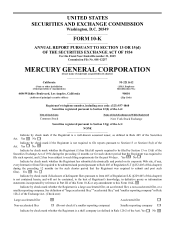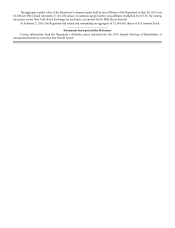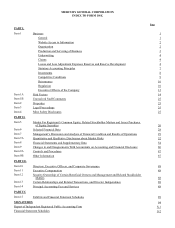Mercury Insurance 2015 Annual Report Download - page 19
Download and view the complete annual report
Please find page 19 of the 2015 Mercury Insurance annual report below. You can navigate through the pages in the report by either clicking on the pages listed below, or by using the keyword search tool below to find specific information within the annual report.7
Statutory Accounting Principles
The Company’s results are reported in accordance with GAAP, which differ in some respects from amounts reported under
SAP prescribed by insurance regulatory authorities. Some of the significant differences under GAAP are described below:
• Policy acquisition costs such as commissions, premium taxes, and other costs that vary with and are primarily related
to the successful acquisition of new and renewal insurance contracts, are capitalized and amortized on a pro rata basis
over the period in which the related premiums are earned, whereas under SAP, these costs are expensed as incurred.
• Certain assets are included in the consolidated balance sheets, whereas under SAP, such assets are designated as
"nonadmitted assets," and charged directly against statutory surplus. These assets consist primarily of premium
receivables that are outstanding for more than 90 days, deferred tax assets that do not meet statutory requirements for
recognition, furniture, equipment, leasehold improvements, capitalized software, and prepaid expenses.
• Amounts related to ceded reinsurance are shown gross as prepaid reinsurance premiums and reinsurance recoverables,
whereas under SAP, these amounts are netted against unearned premium reserves and losses and loss adjustment
expenses reserves.
• Fixed-maturity securities are reported at fair value, whereas under SAP, these securities are reported at amortized cost,
or the lower of amortized cost, or fair value, depending on the specific type of security.
• Equity securities are marked to market through the consolidated statements of operations, whereas under SAP, these
securities are marked to market through unrealized gains and losses in surplus.
• Goodwill is reported as the excess of cost of an acquired entity over the fair value of the underlying assets and assessed
periodically for impairment. Intangible assets are amortized over their useful lives. Under SAP, goodwill is reported
as the excess of cost of an acquired entity over the statutory book value and amortized over 10 years. Its carrying value
is limited to 10% of adjusted surplus. Under SAP, intangible assets are not recognized.
• The differing treatment of income and expense items results in a corresponding difference in federal income tax
expense. Changes in deferred income taxes are reflected as an item of income tax benefit or expense, whereas under
SAP, changes in deferred income taxes are recorded directly to statutory surplus as regards policyholders. Admittance
testing under SAP may result in a charge to unassigned surplus for non-admitted portions of deferred tax assets. Under
GAAP, a valuation allowance may be recorded against the deferred tax assets and reflected as an expense.
• Certain assessments paid to regulatory agencies that are recoverable from policyholders in future periods are expensed,
whereas under SAP, these assessments are recorded as receivables.
Operating Ratios (SAP basis)
Loss and Expense Ratios
Loss and expense ratios are used to interpret the underwriting experience of property and casualty insurance companies.
Under SAP, losses and loss adjustment expenses are stated as a percentage of premiums earned because losses occur over the life
of a policy, while underwriting expenses are stated as a percentage of premiums written rather than premiums earned because
most underwriting expenses are incurred when policies are written and are not spread over the policy period. The statutory
underwriting profit margin is the extent to which the combined loss and expense ratios are less than 100%.
























